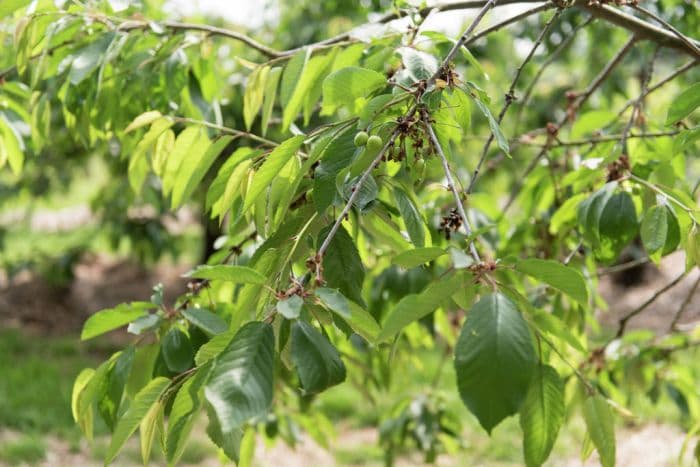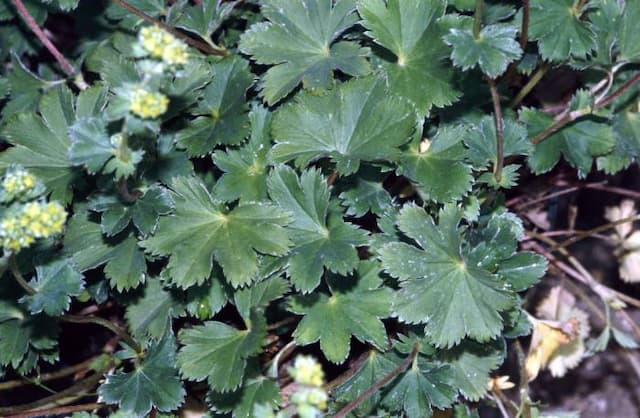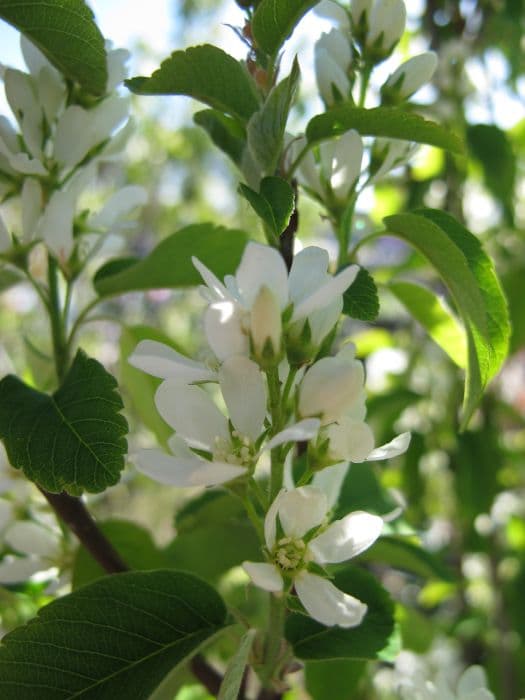Sweet Cherry Prunus avium 'Kordia' (D)

ABOUT
The Prunus avium 'Kordia' is commonly known as the 'Kordia' cherry. This deciduous tree is cherished for its productivity and the quality of its fruit. The plant boasts a rounded to spreading canopy filled with oval-shaped, glossy, green leaves that create a lush backdrop for its springtime display. The edges of the leaves are finely serrated, giving them a subtly textured appearance. As spring arrives, 'Kordia' cherry is adorned with clusters of striking white flowers. These blossoms are notably attractive and can be a magnet for pollinators, providing a delightful show that signals the coming of warmer days. Following the floral display, shiny, deep red cherries begin to develop. The cherries of the 'Kordia' are known for their size, being larger and heart-shaped compared to other varieties. The fruit ripens mid-season, and once fully mature, cherries present not only a deep red, almost burgundy color, but also feature firm flesh that is both sweet and tart, making them highly sought after for fresh eating and culinary uses. The glossy sheen of the cherry's skin makes them quite visually appealing whether they are still hanging on the branches or collected in a basket for consumption. As the fruiting season ends and summer progresses, the green leaves maintain their robust appearance before turning into shades of yellow and orange as cooler autumn temperatures settle in. This creates an aesthetically pleasing seasonal transition that marks the end of the growing cycle for the 'Kordia' cherry.
About this plant
 Names
NamesSynonyms
Kordia Cherry, Sweet Cherry Kordia
Common names
Prunus avium 'Kordia'.
 Toxicity
ToxicityTo humans
The common name for Prunus avium 'Kordia' is sweet cherry. Sweet cherry fruits are not toxic to humans and are commonly consumed. However, the seeds inside the cherries contain compounds that can release cyanide when ingested in large quantities. Chewing and ingesting a large number of cherry seeds could cause cyanide poisoning. Symptoms of cyanide poisoning include difficulty breathing, headaches, dizziness, confusion, vomiting, and increased heart rate, which can potentially be fatal if not treated promptly. It's crucial to note that accidental ingestion of a few cherry seeds is not likely to cause harm due to the low concentration of cyanide precursors and the body's capability to detoxify small amounts of cyanide.
To pets
Sweet cherry, known scientifically as Prunus avium 'Kordia', can be toxic to pets if they ingest parts of the plant other than the ripe pulp. The primary concern lies with the seeds, stems, and leaves, which contain cyanogenic glycosides that can convert into cyanide when ingested, especially if chewed. If a pet eats enough of these parts, symptoms of cyanide poisoning might manifest, such as panting, dilated pupils, difficulty breathing, and shock. In severe cases, it can lead to death. Therefore, it's essential to keep these parts of the plant away from pets. The ripe fruit pulp is generally not harmful to pets, but it is still recommended to offer it in moderation to prevent any gastrointestinal upset.
 Characteristics
CharacteristicsLife cycle
Perennials
Foliage type
Deciduous
Color of leaves
Green
Flower color
White
Height
20 feet (6 meters)
Spread
15 feet (4.5 meters)
Plant type
Tree
Hardiness zones
5
Native area
Europe
Benefits
 General Benefits
General Benefits- Aesthetic Appeal: Prunus avium 'Kordia' is a cherry species known for its beautiful spring blossom and attractive fall foliage, enhancing garden aesthetics.
- Fresh Fruits: It produces delicious sweet cherries that can be eaten fresh, directly from the tree.
- Culinary Uses: The cherries are versatile in the kitchen, used in various recipes including pies, jams, and desserts.
- Wildlife Attraction: The flowers provide nectar for pollinators like bees, while the fruits attract birds.
- Shade Provider: Being a tree, it can offer a significant amount of shade during the hot summer months.
- Wood Production: The wood is valued for its hardness and grain, making it suitable for furniture and flooring.
 Medical Properties
Medical PropertiesThis plant is not used for medical purposes.
 Air-purifying Qualities
Air-purifying QualitiesThis plant is not specifically known for air purifying qualities.
 Other Uses
Other Uses- Woodworking: The hard, dense wood of the cherry tree can be utilized in the making of furniture, cabinets, and specialty wood items due to its fine grain and attractive appearance.
- Ornamental Use: Cherry trees, including the Kordia variety, are often planted in landscapes and gardens for their beautiful blossoms and aesthetic appeal.
- Wildlife Habitat: Cherry trees provide shelter and food for various bird species, bees, and butterflies, enhancing biodiversity in the area.
- Educational Use: Cherry trees can be used in educational settings, like schools and botanical gardens, to teach about plant biology, pollination, and fruit development.
- Craft Materials: The dried branches and twigs of cherry trees can be used in crafting, for items like wreaths or as natural decor elements.
- Ink and Dye Production: The fruit from cherry trees can be used to make natural dyes or inks for art projects and fabric dyeing.
- Culinary Experiments: Cherry wood chips are sometimes used in smoking meats to impart a unique flavor that complements the food.
- Photography and Painting Subjects: The picturesque blossoms and fruit of cherry trees make them ideal subjects for photographers and painters.
- Musical Instruments: Some specialty musical instruments, such as woodwind bodies and certain percussion instruments, are crafted from cherry wood for its tonal qualities.
- Traditional Games: In some cultures, cherry pits are used in traditional children's games or as counters in board games.
Interesting Facts
 Feng Shui
Feng ShuiThe Sweet Cherry Tree is not used in Feng Shui practice.
 Zodiac Sign Compitability
Zodiac Sign CompitabilityThe Sweet Cherry Tree is not used in astrology practice.
 Plant Symbolism
Plant Symbolism- Love and Romance: As a cherry tree, Prunus avium 'Kordia' symbolizes love and romance due to the beauty of its blossoms, which are commonly associated with the tenderness and intensity of emotions in relationships.
- Spring and Renewal: Cherry trees herald the arrival of spring, representing new beginnings, rebirth, and the awakening of life after the cold winter months.
- Beauty and Life: The cherry tree's brief bloom signifies the transitory nature of life, as well as its beauty; reminding us to appreciate our existence and the beauty around us.
- Educational Achievement: In Japan, cherry blossoms are associated with the time of graduation, symbolizing educational achievement and the hopeful journey of the youth into their future careers.
 Water
WaterSweet Cherry trees, including the Kordia variety, prefer deep watering to encourage proper root development. During the growing season, water the tree once a week with about 15-20 gallons of water, ensuring moisture reaches 8-12 inches deep. In the absence of rain, increase the frequency to twice a week. During the dormant season, watering can be scaled back to every 2-3 weeks, depending on the soil moisture level and weather conditions. Always check the soil moisture before watering to avoid over-irrigation, as excessive water can lead to root rot.
 Light
LightSweet Cherry trees require full sun exposure to thrive, which means they should receive at least six hours of direct sunlight daily. The best spot for planting is in an open area away from buildings or shade trees to ensure unobstructed light throughout the day. Avoid placing them in locations where they will be shaded, as this can diminish fruit production and overall health.
 Temperature
TemperatureSweet Cherry trees, such as the Kordia variety, are hardy and can survive winter temperatures as low as -20 degrees Fahrenheit, but the blossoms are more delicate and can be damaged by late spring frosts. The ideal growing temperatures for this cherry tree are between 35 and 75 degrees Fahrenheit. Hot temperatures above 95 degrees Fahrenheit can stress the tree and affect fruit development.
 Pruning
PruningPruning Sweet Cherry trees like Kordia is essential to maintain their shape, encourage strong branch development, and improve air circulation, which reduces the risk of disease. Prune in late winter or early spring before the growing season starts, removing dead or diseased wood, inward-growing branches, and thinning the canopy to allow light penetration. Moderate annual pruning is recommended, focusing on shaping the tree and creating a strong structure.
 Cleaning
CleaningNot needed
 Soil
SoilSweet Cherry 'Kordia' thrives in well-draining, loamy soil with a pH of 6.0 to 7.5. A mix of garden soil, compost, and perlite or sand is ideal to provide the necessary drainage and nutrients.
 Repotting
RepottingSweet Cherry 'Kordia' trees, when grown in containers, should be repotted every 3-5 years, depending on growth rate and root crowding.
 Humidity & Misting
Humidity & MistingSweet Cherry 'Kordia' prefers a moderate humidity level, which typically aligns with outdoor ambient conditions rather than specific humidity requirements.
 Suitable locations
Suitable locationsIndoor
Not suitable for indoor growth due to size and light needs.
Outdoor
Plant in full sun, water deeply, ensure good drainage, prune annually for health.
Hardiness zone
4-7 USDA
 Life cycle
Life cycleThe 'Kordia' cherry, a cultivar of Prunus avium, starts its life as a seed which, once planted and in ideal conditions, will germinate and sprout, marking its first stage of life. As the seedling grows, it enters the vegetative stage, wherein the plant focuses on leaf and stem growth, establishing a strong root system. With proper care and time, usually after several years, the 'Kordia' cherry tree will reach maturity and begin to flower in the spring, characterized by clusters of white blossoms. Following pollination, typically by bees, these flowers transform into cherries, signaling the fruiting stage which occurs in the early summer. The fruits, once ripe, can be harvested and seeds can be dispersed, either through human cultivation or naturally, to give rise to new cherry plants. Finally, as a perennial, the 'Kordia' cherry tree enters a period of dormancy in the winter, shedding its leaves and preserving energy to restart the cycle with new growth in the following spring.
 Propogation
PropogationPropogation time
Spring to Summer
The Sweet Cherry 'Kordia' is most commonly propagated through grafting, particularly during the dormant season when the plant is not actively growing, typically in late winter or early spring. In grafting, a scion, which is a cutting from a mature 'Kordia' cherry tree with desirable characteristics, is carefully attached to the rootstock of a different cherry variety that has a robust root system. The scion should be about 6 to 8 inches (15 to 20 centimeters) long and have at least two or three buds. A compatible rootstock is chosen for its hardiness and disease resistance. The graft union is bound with grafting tape or a similar material and coated with a sealing compound to prevent drying out. The site of grafting must be kept under suitable conditions, ensuring that the newly grafted plant maintains high humidity and moderate temperatures to encourage successful healing and union of the graft.









